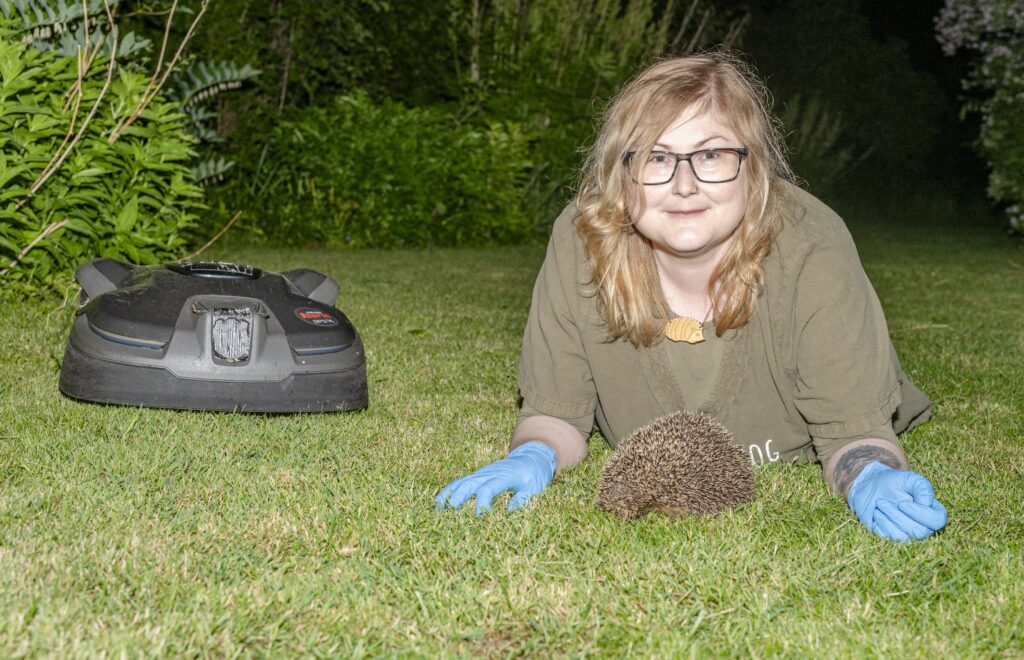Research: Hedgehog crash test dummy
24th June 2025
Meet Sophie
Dr Sophie Lund Rasmussen (also known as Dr Hedgehog) of WildCRU, University of Oxford, has been researching robotic lawnmowers and their effect on hedgehogs (see our previous post). Sophie’s latest project focused on creating a realistic crash test dummy for determining the hedgehog safety of robotic lawnmowers.

Introduction
European hedgehogs increasingly live in areas populated by humans. However, the downside of sharing habitats with people is that residential gardens have potential dangers for hedgehogs. These dangers include robotic lawnmowers, which are widely used in Europe and are gaining popularity here in the UK.
Sophie’s studies have aimed to:
- Provide more insight into the effect of different models of robotic lawnmowers on hedgehogs
- Find out if there are technical features that could increase the safety for hedgehogs
- Determine the optimal standardised safety test for hedgehogs
Methods
Sophie tested 19 different models of robotic lawnmowers from a wide range of brands, models, and specifications that are available in Europe. The tests were performed on cadavers (dead hedgehogs) who had died primarily due to infections, at hedgehog rehab centres.
These cadavers were put in 6 different positions to mimic the activities of living hedgehogs. These positions included head facing the lawn mower and snout at 12 o’clock, snout facing 2 or 3 o’clock, and snout facing 9 or 10 o’clock.
5 damage categories, from 0-4, were used to show the severity of damage caused by the robotic lawnmowers. For example, a score of 0 meant that there was no physical contact between the lawnmower and the hedgehog because the machine sensed the hedgehog from a distance, while a score of 4 meant that the robotic lawnmower failed to detect the presence of the hedgehog and the blades caused injuries to the cadaver.
The methods built on Sophie’s previous study (2020) and the data analysis combined the 2020 data with the current data.
Results

All of the robotic lawnmowers had to physically touch the hedgehog cadavers to detect them. After detection, some of the lawnmowers changed direction so they did not cause injury to the hedgehogs (damage categories 1–2) while others caused injury (damage category 4). Larger-sized (taller) hedgehogs were less likely to be injured. There was little evidence that the position of the hedgehogs affected the risk of injury. There was very little evidence that any of the technical features of the tested lawnmowers affected the risk of injury.
Proposed safety test:
This study provided insights that helped the researchers design a protocol for testing the hedgehog safety of robotic lawnmowers.
This included that:
- The standardised safety test should include two sizes of hedgehog crash test dummies: one a similar size to a juvenile hedgehog and another a similar size as an adult hedgehog.
- Only robotic lawnmowers with damage categories 0–2 in the tests should be labelled as safe for hedgehogs
The researchers designed an optimal hedgehog crash test dummy to be used as a standard model for testing the hedgehog-safety of robotic lawnmowers.
The researchers are keen on providing an open-access model so that manufacturers can 3D print the crash test dummy to develop hedgehog-friendly robotic lawnmowers.

Hopes for the Future
Sophie hopes that the safety test developed in this study will allow for a labelling system that shows whether a robotic lawn mower is hedgehog-safe. Her ambition is to make the final adjustments to the crash test dummy. She wants to optimise it to represent reality and become an important tool for manufacturers, and for it to be used in the safety tests. A hedgehog safety test will soon be implemented by the European Garden Machinery Federation (EGMF), an umbrella organisation for the manufacturers of robotic lawnmowers.
A labelling system could enable consumers to purchase hedgehog-friendly robotic lawnmowers.
And in the meantime, robotic lawnmower owners can help protect hedgehogs by only running them in daylight hours and ensuring that there are no hedgehogs on the grass before turning on the machine.
Watch the Explainer Video
Read the full papers behind the research here:

